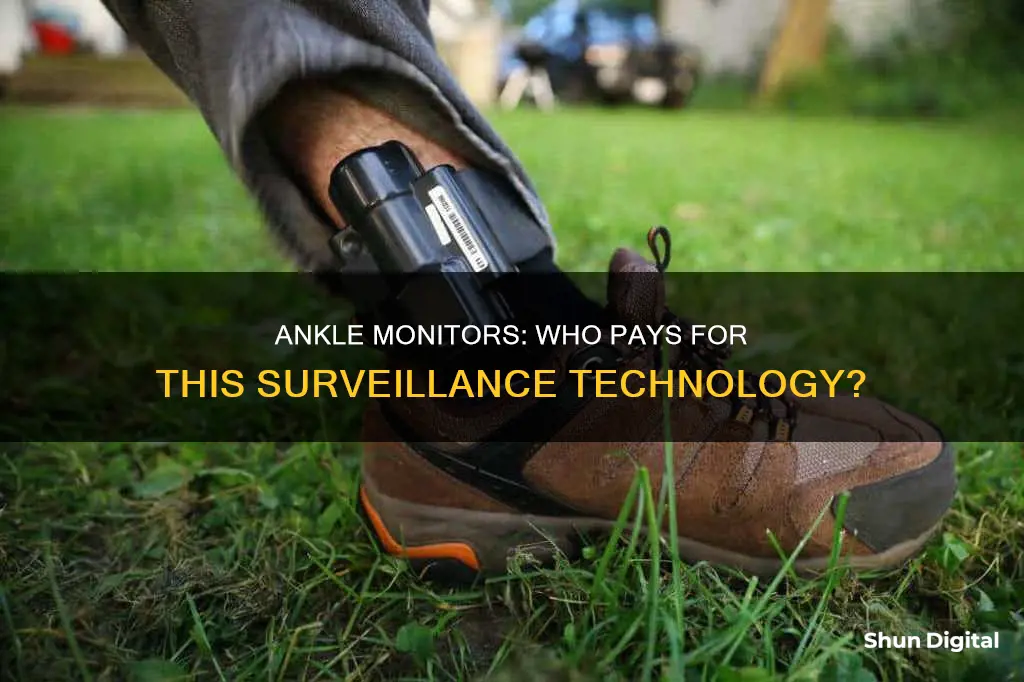
Ankle monitors, also known as ankle bracelets, ankle shackles, or tethers, are GPS tracking devices used to monitor the location of their wearers. These devices are typically worn by people awaiting trial, serving probation or parole, or facing immigration proceedings. While ankle monitors are touted as a way to reduce incarceration rates, they come at a cost for the wearer. In the US, fees for ankle monitors range from $3 to $35 per day, in addition to initial setup charges that can reach $200. This has sparked debates about the ethics of monetizing tracking devices, with some arguing that it further penalizes those who are already struggling and exacerbates systemic inequities.
| Characteristics | Values |
|---|---|
| Who pays for ankle monitors? | In most states, the individuals wearing the monitors are required to pay. |
| In 2022, California passed legislation expressly prohibiting the use of EM fees. | |
| Rhode Island prohibits EM fees for those not yet convicted of an offense, but allows them as a condition of a sentence. | |
| Six states and the District of Columbia lack statutory authority for EM fees, but this doesn't necessarily prevent fees from being charged. | |
| Illinois, Kentucky, Missouri, and Nevada are the only states that require consideration of a person's ability to pay when assessing EM fees. | |
| How much do ankle monitors cost? | Setup costs $50, with a daily maintenance fee of about $14. |
| This amounts to over $400 per month, or even about $1,000 in places like San Francisco. | |
| The GTM MT-200X ankle tracker has a monthly subscription fee of $27. |
What You'll Learn

Who pays for ankle monitors?
In the United States, ankle monitors are often paid for by the individuals required to wear them. These fees are imposed as a condition of probation, parole, diversion, or some other community-based sentence, or as a condition of pretrial release for those who have not been found guilty. In most states, individuals are required to pay daily, weekly, monthly, or flat fees to be tracked and monitored.
However, the cost of ankle monitors can be high, and some people argue that these fees further punish individuals who are trying to reintegrate into society. Some states have recognized this issue and taken steps to address it. For example, California passed legislation in 2022 expressly prohibiting the use of electronic monitoring fees. Similarly, Rhode Island prohibits EM fees for those not yet convicted of an offense, but still allows them as a condition of a sentence.
On the other hand, some people argue that the individuals who committed the crime should bear the cost of their punishment, rather than society as a whole. They believe that if a person cannot pay the fees for an ankle monitor, they should remain incarcerated.
Ultimately, the question of who pays for ankle monitors is complex and multifaceted, balancing the need for public safety and accountability with the potential for excessive financial burden on individuals who are already marginalized.
Speakers and LCD Monitors: Can They Coexist?
You may want to see also

How much do they cost?
The cost of ankle monitors varies depending on location and the company providing the device. In the United States, the cost of ankle monitors ranges from $20 to $400 per month. For example, in New York State, the average bail set for a misdemeanour case is $1,000, and $5,000 for a felony case. However, 63% of employed people in the United States cannot afford a $500 emergency expense, let alone bail money.
In addition to the monthly fee, there may be other costs associated with the ankle monitor. For instance, setting up the device can cost around $50, and daily maintenance can be approximately $14. Over time, these costs can add up, and individuals may end up paying thousands of dollars for the ankle monitor.
It is worth noting that some states, like California and Rhode Island, have passed legislation prohibiting the use of fees for ankle monitors, recognising the economic burden it can place on individuals.
Setting Up Saffire: Monitor Connection Guide
You may want to see also

Are there alternatives to ankle monitors?
Ankle monitors are one way to track individuals who are under the supervision of the criminal justice system. They are often used as an alternative to traditional imprisonment, allowing individuals to serve their sentences while remaining in the community.
However, ankle monitors are not always a suitable punishment and should be used with discretion. They are not a replacement for imprisonment but a complement to it. The nature of the crime and the offender's risk of recidivism must be considered when deciding whether to use an ankle monitor.
There are several alternatives to ankle monitors that can be used for tracking and monitoring individuals. These include:
- Electronic tagging: This is a broader category of surveillance that includes ankle monitors but also encompasses other forms of electronic devices that can be affixed to a person. Electronic tags can be fitted above the ankle or in other locations on the body. They can be used in combination with GPS technology or radio frequency technology for short-range monitoring.
- Sweat alcohol content monitors: These devices, such as the Secure Continuous Remote Alcohol Monitoring (SCRAM) system, monitor sweat samples to detect alcohol consumption. They are typically used for individuals who have committed alcohol-related crimes.
- Smartphone location-based apps: Location-based apps on smartphones can use GPS technology to determine the device's approximate location. This can be used as a form of monitoring and tracking, similar to ankle monitors.
- GPS-enabled uniforms and backpacks: In Japan, a company has created uniforms and backpacks with built-in GPS technology. This allows for the tracking of individuals, particularly school children, and can be used to summon help in distress situations.
These alternatives to ankle monitors provide different options for tracking and monitoring individuals, depending on the specific circumstances and requirements of the situation. Each of these technologies has its own advantages and disadvantages, and the appropriate alternative will depend on the specific needs and constraints of the situation.
Removing Sticker Residue from Your Monitor: A Quick Guide
You may want to see also

What are the implications of these costs?
The costs of ankle monitors have a range of implications, both for the individuals who wear them and for wider society.
For individuals, the cost of an ankle monitor can be a significant financial burden, especially for those who cannot afford to pay bail. In the case of Mallory Bell, who shared her experience of wearing an ankle monitor on TikTok, the device costs her $400 per month, which has added up to over $3,200 during the eight months she has been wearing it. Such costs can create economic injustice, as people from lower socioeconomic backgrounds may struggle to afford them, on top of legal fees and other financial penalties. This may result in individuals choosing to remain incarcerated rather than pay for an ankle monitor, or even resorting to further criminal activity to cover the costs.
The financial burden of ankle monitors can also impact individuals' ability to reintegrate into society. With limited job prospects due to their criminal record, and the challenge of finding employment with an ankle monitor, the added expense may hinder their ability to support themselves and their families. This could potentially lead to further issues such as homelessness, substance abuse, and a cycle of recidivism.
From a societal perspective, the costs of ankle monitors can influence public safety and the efficiency of the criminal justice system. If individuals cannot afford to pay for an ankle monitor, they may remain in jail, contributing to prison overcrowding and increasing costs for taxpayers. Alternatively, some individuals may choose to forgo the ankle monitor and be released without any form of monitoring, potentially posing a risk to the community.
Furthermore, the cost of ankle monitors can affect public perception of the criminal justice system. Some may view the practice of charging individuals for ankle monitors as exploitative and inhumane, particularly when private companies profit from these devices. This can erode trust in the system and undermine its goals of rehabilitation and reintegration.
Overall, the costs of ankle monitors have far-reaching implications that impact individuals, communities, and the criminal justice system as a whole. While ankle monitors are intended to provide an alternative to incarceration, the financial burden they impose can create additional challenges and inequalities.
The Ultimate Guide to VESA Mounts for ASUS MX279H Monitors
You may want to see also

What are people's views on ankle monitor costs?
Views on the cost of ankle monitors are mixed. Some people believe that the cost of the monitor is justified as it is a better alternative to being in jail. However, others argue that the cost is too high and can be unaffordable for some people, potentially leading to further criminal activity.
Some people argue that the cost of an ankle monitor is a necessary expense for those who want to avoid jail time. They believe that if someone commits a crime, they should be responsible for the cost of their punishment, rather than passing it on to taxpayers. This view is supported by the fact that ankle monitors can be a more affordable option than prison, with the average price of house arrest per year being $6,000, compared to the cost of keeping someone in jail which was $87 billion in 2015. Additionally, ankle monitors can provide individuals with the opportunity to correct their lives and continue with their everyday lives, rather than serving a sentence in prison.
On the other hand, some people believe that the cost of ankle monitors is too high and can be a burden for those who cannot afford it. For example, in a viral video, Mallory Bell shared that she pays $400 per month for her ankle monitor, which has already cost her $3,200. The high cost of ankle monitors can be a problem for those who are unable to afford it, especially since it is often an additional expense on top of legal fees and other costs associated with the criminal justice system. In some cases, individuals may be forced to take on additional jobs or cut back on necessary expenses in order to cover the cost of the monitor.
There are also concerns that the cost of ankle monitors can create economic injustice, as it may disproportionately affect those who cannot afford it. This can include individuals with low incomes or those who are already struggling financially. In some cases, individuals may be forced to choose between paying for basic necessities and covering the cost of the monitor. Additionally, there are concerns that the cost of ankle monitors may create a cycle of debt and incarceration, as individuals who cannot keep up with the costs may end up back in jail.
Some people argue that the state or government should cover the costs of ankle monitors, especially since it can be more cost-effective for taxpayers than maintaining a defendant in jail. Additionally, there are concerns that the high cost of ankle monitors may defeat the purpose of using them as an alternative to incarceration, as it may not actually reduce the number of people in the criminal justice system.
Overall, while some people believe that the cost of ankle monitors is justified as it provides an alternative to incarceration, others argue that the high cost can create financial hardship and potentially lead to further criminal activity. There are calls for reform and for the state or government to cover the costs in order to reduce the economic burden on individuals and create a more just system.
Uninstalling HP Device Monitoring Framework: A Step-by-Step Guide
You may want to see also
Frequently asked questions
In most states, the individuals required to wear an ankle monitor are also required to pay for them. However, in California and Rhode Island, the use of electronic monitoring fees is prohibited.
Fees to wear ankle monitors range from $3 to $35 a day, in addition to initial setup charges, which can range from $100 to $200.
Ankle monitors are provided by either a governmental agency or a private for-profit company.
Failure to pay fees can lead to extended periods of supervision, additional fees, or even jail.







